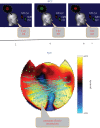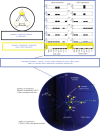Consciousness: here, there and everywhere?
- PMID: 25823865
- PMCID: PMC4387509
- DOI: 10.1098/rstb.2014.0167
Consciousness: here, there and everywhere?
Abstract
The science of consciousness has made great strides by focusing on the behavioural and neuronal correlates of experience. However, while such correlates are important for progress to occur, they are not enough if we are to understand even basic facts, for example, why the cerebral cortex gives rise to consciousness but the cerebellum does not, though it has even more neurons and appears to be just as complicated. Moreover, correlates are of little help in many instances where we would like to know if consciousness is present: patients with a few remaining islands of functioning cortex, preterm infants, non-mammalian species and machines that are rapidly outperforming people at driving, recognizing faces and objects, and answering difficult questions. To address these issues, we need not only more data but also a theory of consciousness-one that says what experience is and what type of physical systems can have it. Integrated information theory (IIT) does so by starting from experience itself via five phenomenological axioms: intrinsic existence, composition, information, integration and exclusion. From these it derives five postulates about the properties required of physical mechanisms to support consciousness. The theory provides a principled account of both the quantity and the quality of an individual experience (a quale), and a calculus to evaluate whether or not a particular physical system is conscious and of what. Moreover, IIT can explain a range of clinical and laboratory findings, makes a number of testable predictions and extrapolates to a number of problematic conditions. The theory holds that consciousness is a fundamental property possessed by physical systems having specific causal properties. It predicts that consciousness is graded, is common among biological organisms and can occur in some very simple systems. Conversely, it predicts that feed-forward networks, even complex ones, are not conscious, nor are aggregates such as groups of individuals or heaps of sand. Also, in sharp contrast to widespread functionalist beliefs, IIT implies that digital computers, even if their behaviour were to be functionally equivalent to ours, and even if they were to run faithful simulations of the human brain, would experience next to nothing.
Keywords: awareness; causation; cerebral cortex; existence; mind body problem; neuronal correlates of consciousness.
Figures





Comment in
-
A comment on Tononi & Koch (2015) 'Consciousness: here, there and everywhere?'.Philos Trans R Soc Lond B Biol Sci. 2016 Feb 5;371(1687):20140198. doi: 10.1098/rstb.2014.0198. Philos Trans R Soc Lond B Biol Sci. 2016. PMID: 26729923 Free PMC article. No abstract available.
-
A reply to Barrett (2016).Philos Trans R Soc Lond B Biol Sci. 2016 Feb 5;371(1687):20150452. doi: 10.1098/rstb.2015.0452. Philos Trans R Soc Lond B Biol Sci. 2016. PMID: 26729941 Free PMC article. No abstract available.
References
-
- Koch C. 2004. The quest for consciousness: a neurobiological approach. Englewood, CO: Roberts and Co.
-
- Baars B, Gage NM. 2010. Cognition, brain, and consciousness. New York, NY: Academic Press.
-
- Laureys S, Tononi G. 2009. The neurology of consciousness: cognitive neuroscience and neuropathology. Amsterdam, The Netherlands: Academic Press.
Publication types
MeSH terms
LinkOut - more resources
Full Text Sources
Other Literature Sources
